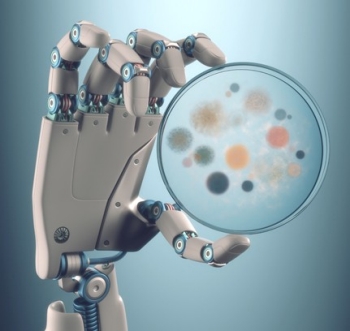A History of Robots in the Lab

By Kerry Connell
From Gort to HAL, from Robby to Rosie (the Jetsons’ maid, in case you forgot), robots have long been a part of our popular culture. The very concept of sentient statues or machines has sparked flights of fancy in myriad spheres, from religion to literature to warfare. In our world, these old robots seem quaint and kitschy — they’re nothing like our industrial and medical machines. Today, robots are technology un-personified: efficient, practical tools that help us accomplish our goals. The many ways we routinely use robotics in the lab would boggle the imaginations of our very imaginative forebears.
Ancient Robots
We tend to think of robots as a modern idea, but the engineers and artists of ancient civilizations all around the world were the first to build (or attempt to build, or at least describe) automated machines. Perhaps the first to succeed was Plato’s friend Archytas, the founder of mathematical mechanics; his self-propelled artificial pigeon reportedly flew approximately 200 meters. A couple of hundred years later, around 270 BC, Ctesibius (the father of pneumatics) created a water clock with animated figures. Ancient mythologians, too, wrote of mechanical people. The Roman god Vulcan was said to have created robot servants. Jewish and Norse legends both Include references to animated clay people. A third century Chinese text, the Lie Zi, includes the story of a mechanical engineer who presented the king with a mechanical man. And, of course, there’s Leonardo daVinci to consider.
The First Modern Robots
The beginning of the 20th century saw the birth of the first modern robots — practical devices like Westinghouse Electric’s Televox and parlor tricks like Elektro, the seven-foot marvel of the 1939 World’s Fair. In 1954, George Devol invented Unimate, the first digitally operated, programmable robotic arm. Unimate transformed automobile manufacturing and kicked off the modern robotics industry. Nearly every industry uses robots now instead of humans for jobs that are too dangerous or for jobs that demand precision and accuracy beyond human ability. Naturally, laboratories have embraced robotics.
Lab-bots
Laboratory robotics began with early applications in peptide and oligonucleotide synthesis. In 1983, Kary Mullis developed the polymerase chain reaction, which uses a computer program to control the temperature to accomplish DNA synthesis and generate copies. Organic chemistry processes also use automated synthesis. In biological labs, robotic equipment can handle standardized microtiter plates, which scientists use to store samples that must be frozen or sealed to avoid degradation or contamination. The Society for Biomolecular Screening developed the microtiter plate standard, and labs everywhere use robotic liquid handlers or plate movers to prepare or move the plates. Standardization is key to the development of robotic technologies. Some companies have developed technology that further automates biological handling. Andrew, by Andrew Alliance, is capable of interfacing with volumetric pipettes, effectively automating the handling processes and removing human error. Other instrumentation companies have developed plate readers that use optical or computer vision to detect specific changes in microtiter plates.
Med-bots
Pharmaceutical companies like McKesson design robots that automate entire pharmacies to eliminate medication errors, and the daVinci Surgical Robot allows surgeons to perform minimally invasive surgery by controlling tiny instruments remotely and viewing their work on a magnified, 3-D display. In the pharmaceutical lab, robotic arms have revolutionized sample preparation for processes like nuclear magnetic resonance and high-performance liquid chromatography-mass spectrometry. The combination of nuclear magnetic resonance and X-ray crystallography allows for the automation of structural protein analysis. Robotics has also made it possible for scientists in combinatorial chemistry pursuits to use very small quantities of reagents to make millions of compounds at once.
Pure-Bots
Robots also perform functions related to purification, such as the automation of simulated distillation (a type of gas chromatography) in the petroleum industry. Automation via microprocessors allows scientists to perform ionexchange separation on a nanoliter scale very quickly.
But What About Humans?
As the science of robotics evolves, so too will our ability to apply automated technologies to laboratory tasks. In fact, a machine called the Robot Scientist (also known as Adam) is a prototype that is able to hypothesize and perform experiments independently. It also interprets its findings without human guidance. Does this mean that human scientists are on their way out? Not at all! Humans — not robots — are the ones with the imagination, passion, drive and insight to investigate challenges and discover answers that can change the lives of people worldwide. We have a stake in our research; robots do not. Besides, humans are the one who can flip the “off” switch.